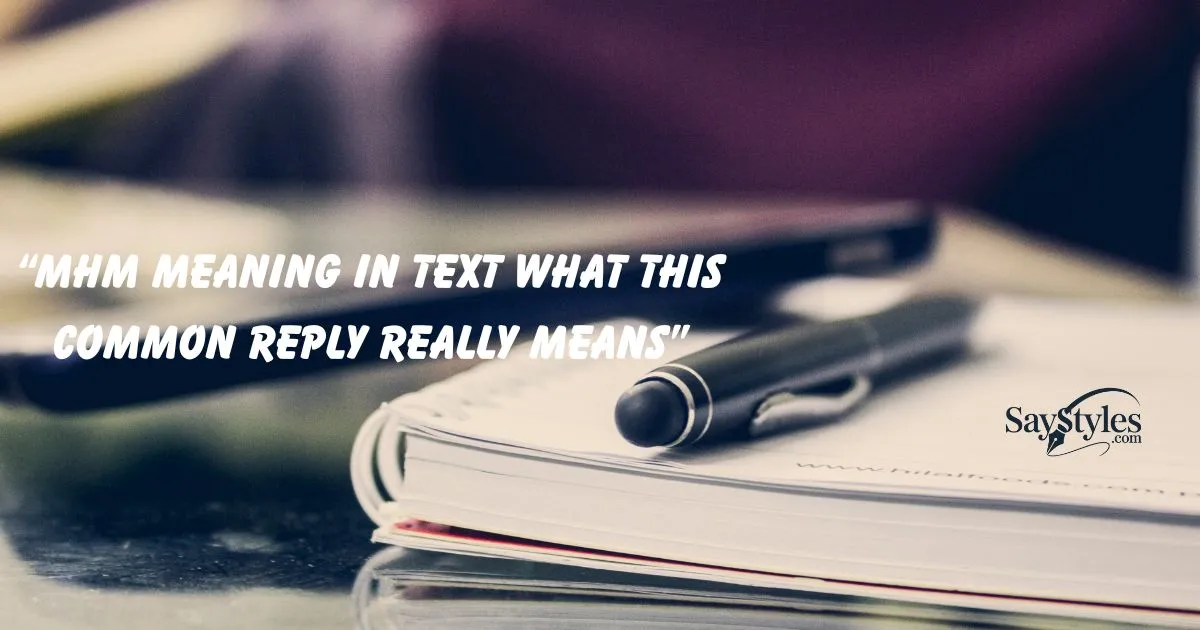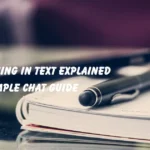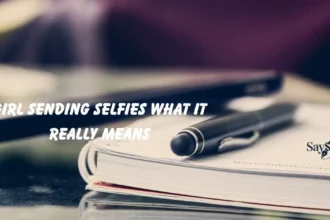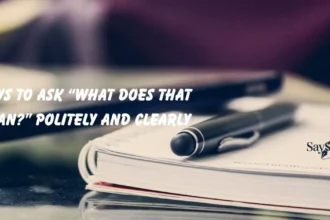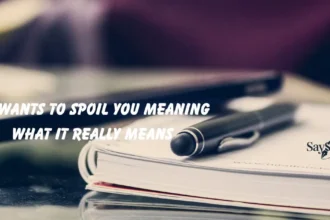Ever gotten a message that just says “MHM” meaning in text and wondered what it really means? In texting and online conversations, MHM meaning in text is a casual way to say “yes,” “yeah,” or “uh-huh.” It’s often used to agree, acknowledge, or show you’re listening, like when someone says, “That movie was amazing,” and you reply, “MHM, totally!”
In digital chats, tone matters a lot. MHM meaning in text can sound friendly, uninterested, or even sarcastic, depending on the context and how it’s written. A long “Mhm…” might sound unsure, while an upbeat “MHM!” shows excitement or agreement. Understanding the vibe and timing of the message helps you know what the sender really means.
In this article, you’ll learn the true meaning of MHM, meaning in text how to interpret it in different situations, and examples that show what it really says about someone’s mood or tone.
What Does “MHM” Mean in Text?
In texting, “MHM” simply means “Yes” or “Yeah.” It’s a quick, casual way to show agreement or acknowledgment without typing a full response. The sound “mm-hmm” is something we naturally say in real conversations — and “MHM” is just the text version of that sound.
People use it to show they’re listening, agreeing, or following along — often when they don’t want to type a long reply.
Real-World Examples:
- “You like that movie?” → “Mhm, it’s good.”
- “Did you get my message?” → “Mhm.”
- “So you’re okay with that plan?” → “Mhm, sounds fine.”
However, “MHM” can also carry different tones depending on context:
- Positive: Genuine agreement (“Mhm, totally agree!”)
- Neutral: Just acknowledging something (“Mhm.”)
- Irritated or dismissive: Slightly cold reply when someone’s done talking (“Mhm…”).
So, “MHM” can mean a simple yes — or a polite way of ending a chat without saying much more.
See also: HMU Meaning in Text What It Really Means and When to Use
Best Alternatives to “MHM”
“MHM” might be short, but there are tons of ways to express the same idea with different tones. Here’s how to say it based on context or emotion:
🗨️ Casual & Everyday
- “Yeah.” → Simple and relaxed.
- “Yup.” → Friendly and easygoing.
- “Sure.” → Agreeing without much excitement.
- “Okay.” → Neutral acknowledgment.
- “Totally.” → Agreeing enthusiastically.
- “Got it.” → Understanding and confirming.
- “Cool.” → Light, conversational acceptance.
💼 Professional or Polite
- “Yes, absolutely.” → Confident and clear.
- “That works for me.” → Agreeing politely.
- “I understand.” → Respectful acknowledgement.
- “Sounds good.” → Warm yet professional.
- “I agree.” → Neutral, formal tone.
- “I’m on board.” → Cooperative and positive.
😅 Emphatic or Supportive
- “Exactly!” → Strong agreement.
- “You’re right.” → Affirming politely.
- “I know, right?” → Relatable and conversational.
- “Same here.” → Showing mutual understanding.
- “True!” → Quick and supportive response.
- “I feel you.” → Emotional connection and empathy.
😜 Playful or Flirty
- “Mhm, really?” → Curious or teasing tone.
- “Oh yeah?” → Flirty or intrigued.
- “Uh-huh 😉” → Playful agreement.
- “I see you 😏.” → Light teasing or flirtation.
- “You think so?” → Coy, friendly challenge.
Each phrase carries its own emotional tone — from chill to affectionate. Choose the one that fits your conversation vibe.
“MHM” in Texting / Messaging
Here are 20 real examples of how “MHM” shows up in chats — and what it usually means in context:
- “Mhm.” → Neutral acknowledgment.
- “Mhm, I know.” → Agreement with a hint of familiarity.
- “Mhm, sure.” → Slight sarcasm or doubt.
- “Mhm, tell me more.” → Curious and engaged.
- “Mhm 😌.” → Playful or satisfied tone.
- “Mhm, that’s true.” → Confirming politely.
- “Mhm, you’re right.” → Supportive and agreeable.
- “Mhm 😒.” → Annoyed or unimpressed.
- “Mhm okay.” → Mild disinterest or short acknowledgment.
- “Mhm 😂.” → Laughing agreement.
- “Mhm, I get it.” → Understanding and listening.
- “Mhm, I told you so.” → Light teasing.
- “Mhm, sounds good.” → Agreeing casually.
- “Mhm 😍.” → Flirty or affectionate tone.
- “Mhm… if you say so.” → Doubtful or skeptical.
- “Mhm, go on.” → Encouraging the other person to continue.
- “Mhm, that’s interesting.” → Engaged but neutral.
- “Mhm, not really.” → Soft disagreement.
- “Mhm 😅 yeah.” → Nervous agreement.
- “Mhm, I miss you too.” → Sweet, emotional tone.
💬 Pro Tip: The emoji next to “MHM” often changes the meaning completely. A heart emoji softens it, while a straight face emoji can make it sound cold.
See also: MB Meaning in Text Messages The Real Chat Slang Decoded
When to Use & When to Avoid “MHM”
“MHM” is simple but versatile — still, it’s not always the best choice. Here’s when it works and when it doesn’t:
✅ When to Use “MHM”
- When you want to agree quickly in a casual chat.
- To show you’re listening without interrupting.
- In friendly or flirty conversations.
- When keeping the tone short but positive.
❌ When to Avoid “MHM”
- In professional messages — it can sound lazy or unclear.
- During serious conversations, where tone matters.
- If the other person might misread your mood.
- When you need to express emotion clearly — “yes” works better
📱 Example: Instead of saying “Mhm” to your boss, say “Yes, I understand.” It shows clarity and professionalism.
FKey Insight About “MHM Meaning in Text”
1. What does “MHM” mean in text?
In texting, “MHM” is a casual way of saying “yeah,” “uh-huh,” or “yes.” It’s used to show agreement or acknowledgment without typing a full sentence. For example, if someone asks, “Are you coming?” you might reply, “Mhm.”
2. Is “MHM” different from just saying “yes”?
Yes, it’s slightly different. “MHM” feels more relaxed and conversational than a plain “yes.” It’s often used when someone agrees but doesn’t want to sound too formal or serious.
3. Does “MHM” always mean agreement?
Not always. While it usually means “yes,” the tone or context can change its meaning. If someone texts “mhm…” with dots or a slow tone, it can sound sarcastic, uncertain, or even uninterested.
4. How do I know what someone means by “MHM”?
Pay attention to the context, timing, and tone of the message. If the person uses “MHM” quickly in a friendly chat, it’s likely positive. But if it follows a serious message or argument, it might mean they’re not fully convinced.
5. Is it rude to reply with “MHM”?
Not usually. “MHM” is casual, not rude, but it can seem dismissive if used too often or without follow-up. To keep the conversation warm, add a short comment after, like “Mhm, I get you!”
6. Can “MHM” be used in flirty or friendly chats?
Yes! In flirty or playful texting, “MHM” meaning in text can sound teasing or interested, especially when paired with emojis like 😉 or 😏. The tone depends on how well you know the person and the mood of the chat.
7. What’s the difference between “MHM” and “UH-HUH”?
Both mean agreement, but “MHM” is more common in texting, while “uh-huh” is mostly spoken. “MHM” feels smoother and fits better in online conversations.
Final Thoughts
In short, “MHM” means “Yes” but it’s more about tone and attitude than just words. It’s a laid-back, natural way to show agreement in text. Depending on your mood, it can sound friendly, sarcastic, or affectionate.
When used right, “MHM” meaning in text helps you sound real and responsive, just like in spoken conversation. But if clarity or formality matters, go for the full “Yes” instead.
So next time you see “MHM,” meaning in text think about how it’s written with emojis, punctuation, or tone because that’s what really gives it meaning.

I’m Lily Hart, the Admin behind the engaging responses at SayStyles.com! With a knack for blending wit and warmth, I turn every piece of writing into something memorable. From clever advice to fun comebacks, I’m here to make sure every response leaves you smiling and thinking.

